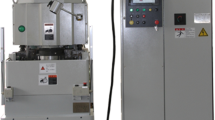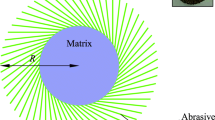Abstract
Internal traverse grinding (ITG) has shown its great potential in precision machining of valves in fuel supply systems. When grinding such valves, long grinding wheels with small diameter are necessary. However, the poor stiffness of grinding wheels causes large deflection of wheel quill during grinding, resulting in deviation between nominal radial feed and actual radial feed, finally reducing the grinding efficiency and consistency of ground parts. In this study, an analytical model on wheel quill deflection was built. Then, a series of ITG tests were conducted to calibrate and validate the model. The results demonstrated that the model showed good accuracy. Furthermore, based on this model, an effective feeding strategy with rapid feed and over feed was proposed to improve the grinding efficiency of ITG.
Similar content being viewed by others
References
Wu D, Li S, Wu P (2015) CFD simulation of flow-pressure characteristics of a pressure control valve for automotive fuel supply system. Energy Convers Manag 101:658–665
Yu TY, Asplund DT, Bastawros AF (2016) Chandra A. Performance and modeling of paired polishing process. Int J Mach Tools Manuf 109:49–57
Guo GQ, Liu ZQ, An QL, Chen M (2011) Experimental investigation on conventional grinding of Ti-6Al-4V using SiC abrasive. Int J Adv Manuf Technol 57:135–142
Klocke F (2009) Manufacturing processes 2: grinding, honing. Springer, Lapping
Xiao G, Malkin S (1996) On-line optimization for internal plunge grinding. CIRP Ann Manuf Technol 45:287–292
Zhang C, Ohmori H, Li W (2000) Precision shaping of small diameter wheels using micro electric discharge truing (MEDT) and hole-machining of Al2O3 material. Int J Mach Tools Manuf 40:661–674
Nadolny K (2015) Small-dimensional sandwich grinding wheels with a centrifugal coolant provision system for traverse internal cylindrical grinding of steel 100Cr6. J Clean Prod 93:354–363
Tawakoli T, Rasifard A, Rabiey M (2007) High-efficiency internal cylindrical grinding with a new kinematic. Int J Mach Tools Manuf 47:729–733
Zhang YB, Li CH, Zhang Q, Jia DZ, Wang S, Zhang DK, Mao C (2016) Improvement of useful flow rate of grinding fluid with simulation schemes. Int J Adv Manuf Technol 84:2113–2126
Wang YG, Li CH, Zhang YB, Yang M, Li BK, Jia DZ, Hou YL, Mao C (2016) Experimental evaluation of the lubrication properties of the wheel/workpiece interface in minimum quantity lubrication (MQL) grinding using different types of vegetable oils. J Clean Prod 127:487–499
Biermann D, Holtermann R, Menzel A, Schumann S (2016) Modelling and simulation of thermal effects in internal traverse grinding of hardened bearing steel. CIRP Ann Manuf Technol 65:321–324
Schumann S, Siebrecht T, Kersting P, Biermann D, Holtermann R, Menzel A (2015) Determination of the thermal load distribution in internal traverse grinding using a geometric-kinematic simulation. Procedia CIRP 31:322–327
Khorasani AM, Gibson I, Godarzvand Chegini N, Goldberg M, Ghasemi AH, Littlefair G (2016) An improved static model for tool deflection in machining of Ti–6Al–4V acetabular shell produced by selective laser melting. Measurement 92:534–544
Saini DP, Brown RH (1980) Elastic deflections in grinding. CIRP Ann Manuf Technol 29:189–194
Gok A, Gologlu C, Demirci HI (2013) Cutting parameter and tool path style effects on cutting force and tool deflection in machining of convex and concave inclined surfaces. Int J Adv Manuf Technol 69:1063–1078
Yamauchi K, Takagi JI (2002) Study on internal grinding of small bore. In: Inasaki I(ed) Springer US, New York, pp 466–470
Cao J, Wu Y, Li J, Zhang Q (2015) A grinding force model for ultrasonic assisted internal grinding (UAIG) of SiC ceramics. Int J Adv Manuf Technol 81:875–885
Cao J, Wu Y, Lu D, Fujimoto M, Nomura M (2014) Fundamental machining characteristics of ultrasonic assisted internal grinding of SiC ceramics. Mater Manuf Process 29:557–563
Brinksmeler E, Glwerzew A (2003) Chip formation mechanisms in grinding at low speeds. CIRP Ann Manuf Technol 52:253–258
Longanbach DM (2000) Real-time measurement for an internal grinding system. Opt Eng 39:2114–2118
Katsuki A, Onikura H, Sajima T, Park H (2005) Development of a laser-guided deep-hole internal-grinding tool (series 1): grinding forces. Memoirs of the Faculty of Engineering, Kyushu University 65:143–155
Katsuki A, Onikura H, Sajima T, Takei T, Thiele D (2000) Development of a high-performance laser-guided deep-hole boring tool: optimal determination of reference origin for precise guiding. Precis Eng 24:9–14
Inasaki I (1991) Monitoring and optimization of internal grinding process. CIRP Ann Manuf Technol 40:359–362
Pereverzev PP, Popova AV, Pimenov DY (2015) Relation between the cutting force in internal grinding and the elastic deformation of the technological system. Russ Eng Res 35:215–217
Syoji K (2004) Grinding manufacturing. Yokendo, Tokyo
Shi Z, Malkin S (2006) Wear of electroplated CBN grinding wheels. Transactions of the ASME. J Manuf Science and Eng 128:110–118
Yu TY, Bastawros AF, Chandra A (2015) Modeling wear process of electroplated CBN grinding wheel. In: Proceedings of the ASME 2015 International Manufacturing Science and Engineering Conference, Jun. 8–12, 2015, Charlotte, North Carolina, USA. P. 1–7
Li A, Zhao J, Wang Z, Zheng W (2011) Elastic properties of WC-Co cemented carbides. Cemented Carbide 28:194–198 (In Chinese)
Author information
Authors and Affiliations
Corresponding author
Rights and permissions
About this article
Cite this article
Gao, S., Yang, C., Xu, J. et al. Optimization for internal traverse grinding of valves based on wheel deflection. Int J Adv Manuf Technol 92, 1105–1112 (2017). https://doi.org/10.1007/s00170-017-0210-8
Received:
Accepted:
Published:
Issue Date:
DOI: https://doi.org/10.1007/s00170-017-0210-8




